|
|
|
Published
on 19
Sep 2006
|
All rights reserved.
|
|
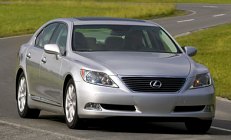 When
Toyota launched Lexus LS400 in 1989, no one would have believed it
could knock out Mercedes and BMW at its first attempt in some of the
most important areas to luxury cars, that is, quietness, ride quality
and build quality. However, the second generation car (LS430) debuted
in 2001 was less impressive as it played the game too safe, too
conservative. It failed to keep the momentum and let European luxury
cars taking the lead again. This time, the third generation, LS460, is
going to strike back. When
Toyota launched Lexus LS400 in 1989, no one would have believed it
could knock out Mercedes and BMW at its first attempt in some of the
most important areas to luxury cars, that is, quietness, ride quality
and build quality. However, the second generation car (LS430) debuted
in 2001 was less impressive as it played the game too safe, too
conservative. It failed to keep the momentum and let European luxury
cars taking the lead again. This time, the third generation, LS460, is
going to strike back.
From its handsome appearance, we can see Lexus is finally taking design
seriously. It has good proportion and execution, if not as elegant as
Audi or Mercedes. Most important, it is entirely original. Remember I
used to criticize the first two generations for copying contemporary
Mercedes S-class ? now the new Lexus has its own character finally.
While LS430 was smaller than its European rivals, LS460 has grown
considerably to align with class standard. It is 45mm longer in
wheelbase and 45mm wider overall. Moreover, to match with rivals it
also offers a LWB version (i.e. LS460 L) which adds 120mm to the
wheelbase. Either versions provide ample of legroom.
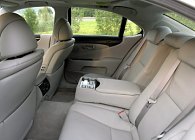 Unfortunately,
the interior design and materials look more like a Toyota Avalon-plus
instead of a bespoke luxury limousine. Its dashboard looks bland. Its
wood trim looks like plastics. And there is no impeccably-built
aluminum switch gears to deliver bespoke feel. In short, this place
simply lacks the sense of occasion that you can find in Mercedes
S-class, BMW 7-Series and Audi A8. Nevertheless, being the flagship
model of Lexus, it is by no means short of luxury equipments: power
rear door closer, power trunk lid closer, heated and vented seats,
heated steering wheel, power reclining rear seats with power leg rests
and built-in massagers, fold tables, DVD video system for the rear
passengers and 19-speaker Mark Levinson audio system. Unfortunately,
the interior design and materials look more like a Toyota Avalon-plus
instead of a bespoke luxury limousine. Its dashboard looks bland. Its
wood trim looks like plastics. And there is no impeccably-built
aluminum switch gears to deliver bespoke feel. In short, this place
simply lacks the sense of occasion that you can find in Mercedes
S-class, BMW 7-Series and Audi A8. Nevertheless, being the flagship
model of Lexus, it is by no means short of luxury equipments: power
rear door closer, power trunk lid closer, heated and vented seats,
heated steering wheel, power reclining rear seats with power leg rests
and built-in massagers, fold tables, DVD video system for the rear
passengers and 19-speaker Mark Levinson audio system.
 Overall,
LS460 is 150 kilograms heavier than LS430, so it needs a larger
4.6-liter V8 and the world's first 8-speed automatic transmission.
Producing 380 horsepower, the new V8 returns higher specific power than
Mercedes S500 (388hp from 5.5 liters) and BMW 750i (367hp from 4.8
liters). Only Audi A8 (now 350hp from 4.2 liters) is slightly more
efficient. Such high level of efficiency is contributed by dual-mode
direct injection, 11.8:1 compression, dual-VVT-i and variable intake
manifolds. Lexus says it has the world's first electrical variable
valve timing mechanism at the intake camshafts (while exhaust camshafts
remain to be driven by hydraulic actuators), but apart from lower costs
and negligible fuel saving I don't see any real advantages. Overall,
LS460 is 150 kilograms heavier than LS430, so it needs a larger
4.6-liter V8 and the world's first 8-speed automatic transmission.
Producing 380 horsepower, the new V8 returns higher specific power than
Mercedes S500 (388hp from 5.5 liters) and BMW 750i (367hp from 4.8
liters). Only Audi A8 (now 350hp from 4.2 liters) is slightly more
efficient. Such high level of efficiency is contributed by dual-mode
direct injection, 11.8:1 compression, dual-VVT-i and variable intake
manifolds. Lexus says it has the world's first electrical variable
valve timing mechanism at the intake camshafts (while exhaust camshafts
remain to be driven by hydraulic actuators), but apart from lower costs
and negligible fuel saving I don't see any real advantages.
However, on the road the engine never feels as powerful as the figures
suggested. This is because the engine is optimized for power rather
than torque (you can see that from the oversquare combustion chambers
with 94mm bore and 83mm stroke). While the max torque of 367 lbft looks
good, one should note that it arrives at a high 4100 rpm. In contrast,
Mercedes' and BMW's V8s produces max torque at 2800 rpm and 3400 rpm
respectively. That make a big difference to the perceived power and
tractability for normal use.
 To compensate for the lack of
low down torque, Toyota ordered its subsidiary gearbox maker, Aisin, to
develop an 8-speed automatic specially for the LS. This goes one up
from Mercedes's already outstanding 7G-Tronic. Having more gears allow
a wider spread of transmission ratio, thus the first and second can be
geared to aid acceleration, the middle gears take care of regular
driving and the highest gears optimized for cruising. Brilliantly,
Aisin managed to make the 8-speeder 10 percent lighter and take the
same space as the outgoing 6-speeder. To compensate for the lack of
low down torque, Toyota ordered its subsidiary gearbox maker, Aisin, to
develop an 8-speed automatic specially for the LS. This goes one up
from Mercedes's already outstanding 7G-Tronic. Having more gears allow
a wider spread of transmission ratio, thus the first and second can be
geared to aid acceleration, the middle gears take care of regular
driving and the highest gears optimized for cruising. Brilliantly,
Aisin managed to make the 8-speeder 10 percent lighter and take the
same space as the outgoing 6-speeder.
The gearbox does help LS460 to deliver competitive performance – say,
0-60 mph acceleration takes only 5.4 seconds – but you have to rev the
engine harder than rivals to deliver such performance. Luckily, the V8
is as impeccably smooth and quiet as ever, as is the transmission.
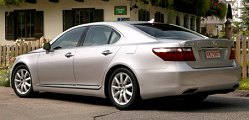 Likewise, the ride quality
keeps the best tradition of Lexus. Its all-round multi-link adaptive
air suspensions offer suppleness and quietness not even Mercedes
S-class can match. The remarkably smooth body, with drag coefficient
only 0.26, makes so little wind noise. Its sound insulation is probably
the most effective in the class. If all you ask is comfort and
refinement, nothing else could be better at this price. Likewise, the ride quality
keeps the best tradition of Lexus. Its all-round multi-link adaptive
air suspensions offer suppleness and quietness not even Mercedes
S-class can match. The remarkably smooth body, with drag coefficient
only 0.26, makes so little wind noise. Its sound insulation is probably
the most effective in the class. If all you ask is comfort and
refinement, nothing else could be better at this price.
However, if you also care about driving pleasure, LS460 will be less
impressive. Although its body control and agility are far
superior than the old car, there is still a clear margin between it and
the leaders from Munich, Stuttgart and Ingolstadt, especially on twisty
roads. Firstly, there is still more body roll than the German cars
because its priority is in ride comfort. Secondly, its brake-by-wire
system suffers from the same weakness as Mercedes-Benz's now defunct
Sensonic Brake Control: the brake pedal has considerable dead slack in
the first part of its travel. When you overcome the slack, the car
brakes suddenly like triggering an on-off switch. It is annoying and
confidence hurting. Lastly but not least, the steering is
uncommunicative, filtering all information from the roads to the
driver's hands. Look at the spec and it is not surprising: it has
switched to a pure electrical power steering system like your Fiat
Punto. Why? Because Lexus needs that for the self-parking system…
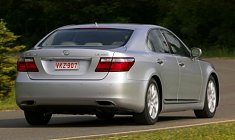 Many
journalists described LS460 as the world's most technological advanced
car. This start from its self-parking system, which can steer the car
into parking space by itself. You stop the car in parallel to the
parking space, then turn on the self-parking function and confirm the
desired parking space displayed from the LCD screen. All you need to do
is to press the throttle and brake pedals while the car turns the
steering wheel by itself. It is convenient for those who can't park a
car, but the self-parking function is limited to parallel parking only
and the whole process is slow. As one journalist said, "It is better to
learn parking by yourself." Many
journalists described LS460 as the world's most technological advanced
car. This start from its self-parking system, which can steer the car
into parking space by itself. You stop the car in parallel to the
parking space, then turn on the self-parking function and confirm the
desired parking space displayed from the LCD screen. All you need to do
is to press the throttle and brake pedals while the car turns the
steering wheel by itself. It is convenient for those who can't park a
car, but the self-parking function is limited to parallel parking only
and the whole process is slow. As one journalist said, "It is better to
learn parking by yourself."
Well, self-parking might sound state of the art to Western journalists
who have not seen or heard about the Japanese-spec Toyota Prius on
which this technology made debut. However, most of the advanced safety
features found in the LS should be familiar to them, because they were
originated by the last generation Mercedes S-class in the name of
"Pre-Safe" system. These include tightening the seat belts,
straightening the headrests, closing windows and boosting brake power
when the radar detects that a collision is about to happen. Lexus only
copied the ideas from Mercedes and expanded the system to cover more
conditions. The only really new technology is a driver monitoring
system, which uses a camera mounted on the steering column to see if
the driver is turning his vision off the roads when there is other cars
coming close. If so, it will sound buzzer to warn the driver, tighten
the seat belts and in emergency condition may even apply braking by
itself.
One publication said, "The new Lexus may not be as pretty as the Audi,
or as powerful as the Mercedes, or as driver-focused as the 750i, but
it is the only one that can park itself." which sounds silly but very
true (BTW, there are too many no-brainers in automotive journalism). If
you need a luxury car that can park itself, LS460 will be the only
choice. If you can park by yourself, choose something else. |
Verdict:     |
Published
on 3
May 2007
|
All rights reserved.
|
|
LS600h
|
|
 Traditionally,
every successful luxury car maker should have an ultra-expensive
12-cylinder model as its range topper. The 12-cylinder model is a
two-edge knife – on the one hand, it boosts the luxury image of the
company. On the other hand, it earns higher profit margin than the
mainstream V8 models. For these reasons, Mercedes, BMW and Audi produce
S600L, 760il and A8L W12 respectively. Until now, Toyota's Lexus
division has yet to join the queue, although its mother company does
have a V12-powered luxury car called Toyota Century offering
exclusively to the ultra-conservative Japanese riches. But forget this
car, as it could never attract any overseas buyers (with the exception
of our unpopular ex-Chief Executive of Hong Kong, Mr. Tung Chee Hwa).
What Toyota tries to push is Lexus. In order to level with its German
rivals, Lexus needs to have a premier version of LS. But instead of
developing a new V12 engine, it chose to offer an electric-petrol
hybrid V8 to showcase its world-leading hybrid technology while marking
itself out of its conventional competitors. The strategy seems quite
sensible. Traditionally,
every successful luxury car maker should have an ultra-expensive
12-cylinder model as its range topper. The 12-cylinder model is a
two-edge knife – on the one hand, it boosts the luxury image of the
company. On the other hand, it earns higher profit margin than the
mainstream V8 models. For these reasons, Mercedes, BMW and Audi produce
S600L, 760il and A8L W12 respectively. Until now, Toyota's Lexus
division has yet to join the queue, although its mother company does
have a V12-powered luxury car called Toyota Century offering
exclusively to the ultra-conservative Japanese riches. But forget this
car, as it could never attract any overseas buyers (with the exception
of our unpopular ex-Chief Executive of Hong Kong, Mr. Tung Chee Hwa).
What Toyota tries to push is Lexus. In order to level with its German
rivals, Lexus needs to have a premier version of LS. But instead of
developing a new V12 engine, it chose to offer an electric-petrol
hybrid V8 to showcase its world-leading hybrid technology while marking
itself out of its conventional competitors. The strategy seems quite
sensible.
With a max power rated at 439 horsepower, Toyota claims it matches a
conventional 6.0-liter V12, therefore it calls the car LS600h, or
LS600h L for the long-wheelbase version. The power unit consists of a
5.0-liter V8, two electric motors (one acts as propulsion power and one
acts as starter / generator), a planetary gear set, a power control
module and a NiMH battery pack. The V8 engine is a stroked out version
of the LS460's unit. Itself alone generates 389 horsepower and 385 lbft
of torque. The electric motors produce another 221 horses, but
concentrated at low rev thus the combined power is only 439hp.
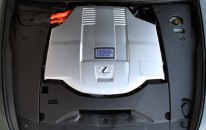 As in
other Toyota hybrid cars, the engine and electric motors are linked by
the planetary gear set, which acts as power split device as well as
transmission. The electric motors run inside the planetary gears. By
varying the speed difference between the two motors, the rev at output
shaft varies in relation to the input shaft from engine. In this way,
the transmission ratio is varied. Toyota calls this E-CVT because it
makes use of electric motors and planetary gears to simulate a
continuously variable transmission. The transmission program also
enables a manual mode with 8 speeds. Brilliantly, the planetary gear
set, electric motors and power control module are packaged within a
longitudinal transmission case located at where conventional automatic
transmission occupy. The battery pack is placed behind the rear seat to
improve balance, but it inevitably reduces luggage capacity from 505
liters to 330 liters. That's the most obvious price you pay for hybrid
technology. As in
other Toyota hybrid cars, the engine and electric motors are linked by
the planetary gear set, which acts as power split device as well as
transmission. The electric motors run inside the planetary gears. By
varying the speed difference between the two motors, the rev at output
shaft varies in relation to the input shaft from engine. In this way,
the transmission ratio is varied. Toyota calls this E-CVT because it
makes use of electric motors and planetary gears to simulate a
continuously variable transmission. The transmission program also
enables a manual mode with 8 speeds. Brilliantly, the planetary gear
set, electric motors and power control module are packaged within a
longitudinal transmission case located at where conventional automatic
transmission occupy. The battery pack is placed behind the rear seat to
improve balance, but it inevitably reduces luggage capacity from 505
liters to 330 liters. That's the most obvious price you pay for hybrid
technology.
What you lost in luggage space is gained back in fuel economy. Rated at
an astonishing 30mpg for EU combined cycle, the super Lexus beats its
European rivals by around 10 mpg ! Although hybrid cars rarely deliver
the promised fuel economy in real-world driving conditions, especially
if you regularly drive on highway and rarely actuate its regenerative
braking, LS600h should still be considerably greener than its
12-cylinder European rivals due to its fewer cylinders (hence less
energy loss) and on-demand alternator and air-conditioning. CO2
emission is equally impressive – 219g per km, versus 340g per km for
Mercedes S600. Besides, it is the only car in its class to be
classified as SULEV (Super Ultra Low Emission Vehicle) in the United
States.
Apart from different powertrains, LS600h differs from LS460 by adding a
permanent 4-wheel-drive system. It employs a Torsen center differential
to split 40/60 torque to front and rear respectively under normal
condition, or up to 70 percent to either axle in case of slippage.
Besides, there is a new active anti-roll bars like BMW 7-Series to
limit body roll. All these features, plus the hybrid hardware and full
luxury equipment add some 375 kilograms on the top of the equivalent
LS460 or LS460L. Now the flagship Lexus tops 2355 kg, around 200-250 kg
heavier than its German rivals. Only Bentley Continental Flying Spur is
heavier, but then again its twin-turbo W12 produces 560 horsepower.
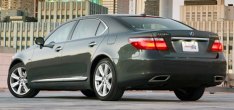 No
wonder LS600h is the slowest in the class. Taking 5.5 seconds to do
0-60 mph acceleration, it is barely faster than LS460 by a whiskey.
More telling is, Audi A8 W12 is half a second quicker, while the
twin-turbo Mercedes S600 - our benchmark of the class - is even a full
second quicker despite of the lack of 4-wheel traction ! The Mercedes
would do 0-100 mph in under 10 seconds, another 3 seconds ahead of the
top Lexus. In fact, a V8-powered S500 (S550) is just as fast. In terms
of performance, LS600h is not in the same league as its 12-cylinder
rivals. No
wonder LS600h is the slowest in the class. Taking 5.5 seconds to do
0-60 mph acceleration, it is barely faster than LS460 by a whiskey.
More telling is, Audi A8 W12 is half a second quicker, while the
twin-turbo Mercedes S600 - our benchmark of the class - is even a full
second quicker despite of the lack of 4-wheel traction ! The Mercedes
would do 0-100 mph in under 10 seconds, another 3 seconds ahead of the
top Lexus. In fact, a V8-powered S500 (S550) is just as fast. In terms
of performance, LS600h is not in the same league as its 12-cylinder
rivals.
However, the luxury manner of LS600h is never in doubt. Its powertrain
is super-smooth and quiet. The already low engine noise is muted by
extra sound insulation which covers the whole engine. The E-CVT
operates seamlessly. The adaptive air suspensions continues to offer a
supple ride. Inside, there is everything a high-tech luxury car needed,
such as a classy Mark Levinson Audio-Visual system, heated-and-cooled
massaging chairs, a refrigerated drink cabinet (for 4-seat version
only), a wonderful climate control that uses infrared beam to monitor
the temperature of passenger body, pre-collision safety system and
again the Big Brother driver monitoring system. A similarly equipped
Mercedes S600L costs 20 percent more, so the flagship Lexus represents
good value for money.
What it can't match its rivals are few: the cabin still looks
mainstream rather than prestige; The V8 rumble is not as classy as the
sound of a V12; The handling is not as engaging as its German rivals,
although active anti-roll bars do improve body control. And then is the
aforementioned shortage of performance. However, put all these factors
together, we inevitably come to this question: is LS600h really a
contender in the same segment as Mercedes S600L, Bentley Continental
Flying Spur, BMW 760il and Audi A8L W12 ? subjectively, it still lacks
the superior feel that separates an exclusive luxury car from a
mainstream luxury car. Performance, comfort or economy, it does not
sound much different from a full-specced LS460L. That is the biggest
problem. |
Verdict:     |
| Published
on 8
Oct
2012 |
All rights reserved.
|
|
Lexus LS 2012 update
|
|

|
6 years is a long time in
the automotive industry. It is normally the lifespan of a generation.
Disappointingly, having waited for 6 years, Lexus gives us only a
facelift of the existing LS. At first, Lexus wanted us to believe it
were a new generation. It declared that half of the 6,000 parts have
been renewed. Unfortunately, those parts apparently do not include the
powertrains. Both the 4.6-liter V8 and 5.0-liter hybrid V8 on LS600h
are carried over from the old car, even though the former is claimed to
deliver 6 more horsepower than before. The 8-speed automatic gearbox is
also unaltered. Pretty much the same can be said to the chassis,
suspension and steering save their fine tunings.
So what have been changed? Outside, the most obvious is the new spindle
grille, which succeeds to deliver a visual impact and destroy the
harmonious appearance simultaneously. It hints at the brand's new
development direction, i.e. to deliver a sportier flavor. Another
testament to the new direction is the addition of LS460 F-Sport model.
As in the case of GS350 F-Sport, it has more aggressive body kits, a
stiffer suspension setting, 10 mm lower ride height, a Torsen limited
slip differential, 19-inch wheels and Brembo brakes, but unfortunately
no more power than the regular LS460. The F-Sport also has its gearbox
programmed to shift faster in Sport mode, and it is finally capable to
blip throttle to match rev. Having said that, even this version is no
match for Jaguar XJ as a keen driver's car, mainly because of its light
and isolated steering, vague brake feel and less incisive body control
at the limit. It is also short of power to challenge its British and
German rivals. The LS460 takes 5.4 seconds to go from rest to 60 mph,
0.8 seconds longer than a BMW 750i.

|
The flagship LS600h is actually slower than its smaller sister,
claiming 5.5 seconds for the same sprint. An unchanged powertrain means
it is no longer a state of the art choice. BMW ActiveHybrid 7 can
easily beat it in fuel consumption and emission.
The biggest improvement is found in the cabin. The old car's
dull-looking dashboard has been replaced with a much classier one,
finished in far better materials and plenty of high tech gadgets. The
center console features the same 12.3-in LCD screen as the GS, while
the instrument pod houses a 5.8-in TFT instrument display. There are
more safety equipment, too. Most notable of which is the A-PCS
pre-collision system which can automatically brakes the car to full
stop when a pedestrian or obstacle is detected in the way of travel. In
principle it is an equal to Volvo's City Safety collision avoidance
system, although its usage is more limited as it works for speed up to
only 38 km/h, compare with Volvo's 50 km/h.
Still, the updated LS is barely a small step forward, failing to keep
up with the pace the class is progressing. As the new Mercedes S-class
is just around the corner, it is difficult to imagine how the Japanese
luxury flagship can soldier on for a few more years .
|
Verdict:    |
|
|
|
|
|
|
|
|
|
|
LS460
|
2006
|
| Front-engined,
RWD |
| Steel monocoque |
| Mainly steel |
| 5030 / 1875 / 1465 mm |
| 2970 mm |
V8, 90-degree
|
| 4608 cc |
DOHC 32 valves, DVVT
|
| VIM |
| DI |
380 hp
|
| 367 lbft |
8-speed automatic
|
All: multi-link
|
Adaptive air springs
|
| 245/45ZR19 |
1870 kg
|
| 155 mph (limited) |
5.4 (c) / 6.0* / 5.6**
|
14.5* / 13.4**
|
|
LS460L
|
2006
|
| Front-engined,
RWD |
| Steel monocoque |
| Mainly steel |
| 5150 / 1875 / 1465 mm |
| 3090 mm |
V8, 90-degree
|
| 4608 cc |
DOHC 32 valves, DVVT
|
| VIM |
| DI |
380 hp
|
| 367 lbft |
8-speed automatic
|
All: multi-link
|
Adaptive air springs
|
| 245/45ZR19 |
1980 kg
|
| 155 mph (limited) |
6.5***
|
15.3***
|
|
LS600h
L
|
2007
|
| Front-engined,
RWD |
| Steel monocoque |
| Mainly steel |
| 5150 / 1875 / 1465 mm |
| 3090 mm |
V8, 90-degree, electric motor
|
| 4969 cc |
DOHC 32 valves, DVVT
|
| VIM |
| DI |
Engine: 389 hp
Motor: 221 hp
Combined: 439 hp
|
| Engine: 385 lbft |
CVT
|
All: multi-link
|
Adaptive air springs,
active anti-roll bars
|
| 245/45ZR19 |
2355 kg
|
| 155 mph (limited) |
5.4** / 5.5****
|
12.6** / 13.2****
|
|
|
|
|
|
Performance
tested by: *C&D, **R&T, ***Autocar, ****MT
|
|
|
|
|
|
|
LS460F Sport
|
2012
|
| Front-engined,
RWD |
| Steel monocoque |
| Mainly steel |
| 5090 / 1875 / 1455 mm |
| 2970 mm |
V8, 90-degree
|
| 4608 cc |
DOHC 32 valves, DVVT
|
| VIM |
| DI |
386 hp
|
| 367 lbft |
8-speed automatic
|
All: multi-link
|
Adaptive air springs
|
| 245/45ZR19 |
1945 kg
|
| 155 mph (limited) |
5.4 (c)
|
-
|
|
LS600h L
|
2012
|
| Front-engined,
RWD |
| Steel monocoque |
| Mainly steel |
| 5210 / 1875 / 1480 mm |
| 3090 mm |
V8, 90-degree, electric motor
|
| 4969 cc |
DOHC 32 valves, DVVT
|
| VIM |
| DI |
Engine: 389 hp
Motor: 221 hp
Combined: 439 hp
|
| Engine: 385 lbft |
CVT
|
All: multi-link
|
Adaptive air springs
|
| 245/45ZR19 |
2285 kg
|
| 155 mph (limited) |
5.5 (c) / 6.3*
|
14.7*
|
|
|
|
|
|
|
| Performance
tested by: *C&D |
|
|
|
|
|
|
|
|
Copyright©
1997-2012
by Mark Wan @ AutoZine
|
|